Recent sightings of the rare blue calamintha bee (Osmia calaminthae) in Florida have captured the public’s interest. Many Floridians may be wondering if the blue bees they see in their yards or communities are the blue calamintha bees. But Florida is home to many metallic blue bees, some of which could be easily confused with the blue calamintha.
Mason bees (Osmia spp.)
The bees that look most similar to the blue calamintha are its close relatives in the mason bee group (Osmia. spp.). These bees are known as mason bees due to their unique behavior of using mud to construct nests. Female bees create nests in narrow cavities like stems or reeds, and use mud to partition individual cells and to cap the nest.
The blue calamintha is one type of mason bee, but there are at least five other Osmia species in Florida, and possibly up to seven species. All Florida species are metallic navy blue with a round, somewhat chunky body shape, though they vary in size from 8 – 15 mm long. Mason bees, including the blue calamintha, are further distinguished by abundant hairs on the underside of their abdomens which can be used to collect pollen.
One identifying feature of the blue calamintha is its close association with Ashe’s calamint (Calamintha ashei), from which it collects pollen. A mason bee collecting pollen from this plant may be the blue calamintha, while mason bees observed on other plants are more likely other species. The blue calamintha also collects pollen on its facial hairs by rubbing its face into flowers, a behavior different from other mason bees that collect pollen on the underside of their abdomens.
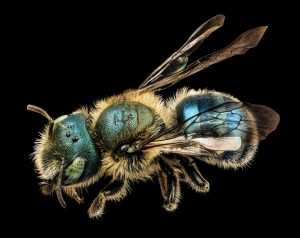
Source: USGS Bee Inventory and Monitoring Lab
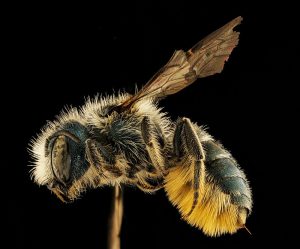
Source: : USGS Bee Inventory and Monitoring Lab

© Rightmyer, M., Deyrup, M., Ascher J., Griswold T. (2011) https://doi.org/10.3897/zookeys.148.1497
/ Wikimedia Commons / CC-BY-SA-3.0 / GFDL. No changes made
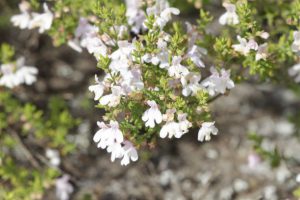
Credit: Chase Kimmel
Sweat bees (family Halictidae)
Some of the most commonly seen blue bees in Florida are sweat bees (Halictidae species). Numerous species of sweat bees live in Florida, and some of these species are metallic blue in color. These bees visit many types of flowers and can often be seen on garden plants.
Sweat bees can be distinguished from the blue calamintha bee by their lighter and brighter shade of blue. (As can be seen above, the blue calamintha is a darker, more navy shade of blue.). Furthermore, these bees do not have the characteristic abundant hairs under their abdomens like the blue calamintha bee and other mason bees.
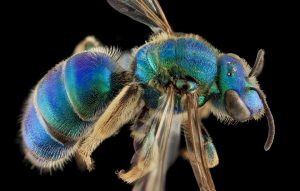
Source: : USGS Bee Inventory and Monitoring Lab
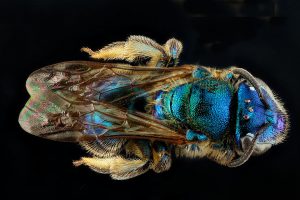
Source: : USGS Bee Inventory and Monitoring Lab
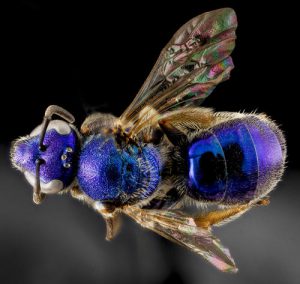
Source: : USGS Bee Inventory and Monitoring Lab
Carpenter bees Ceratina spp. and Xylocopa micans
Though not as commonly seen, there are three species of small carpenter bees (Ceratina spp.) in Florida, two of which are metallic blue. These bees are smaller and more slender than the blue calamintha bee, less than 8 mm in length (a little less than the radius of a dime). Ceratina spp. additionally lack pollen-collecting hairs on the underside of the abdomen and are generally less hairy than the blue calamintha bee.
In addition to these small carpenter bees, a very common and large carpenter bee species found in Florida (Xylocopa micans) often has a dark blue sheen. X. micans is considerably larger than the blue calamintha bee at over 15 mm in length, dark blue-black in coloration, and with no hairs on the underside of the abdomen. Xylocopa micans will forage on a variety of flowers and is frequently seen in urban habitats.

Source: Mike Boone https://bugguide.net/node/view/7692. CC-BY-SA-2.5. No changes made

Source: USGS Bee Inventory and Monitoring Lab
Checklist: Did I find a blue calamintha bee?
- Is it a navy blue bee?
- Was it seen in or around the Lake Wales Ridge region?
- Is it about 10 mm in length and with a round body shape?
- Is it covered in hairs including on the underside of the abdomen?
- Does it collect pollen by rubbing its face into flowers?
If the answer to all of the above is yes, you have may have found a blue calamintha bee!
However, most of the bees described above are considerably more common than the blue calamintha bee. A metallic blue bee that you see in Florida is most likely a sweat bee, another mason bee, or a carpenter bee.
But all of these bees are important in our ecosystems as pollinators for both wild plants and crop plants. So even if it’s not the blue calamintha, you have spotted a beautiful and valuable insect!
 5
5
